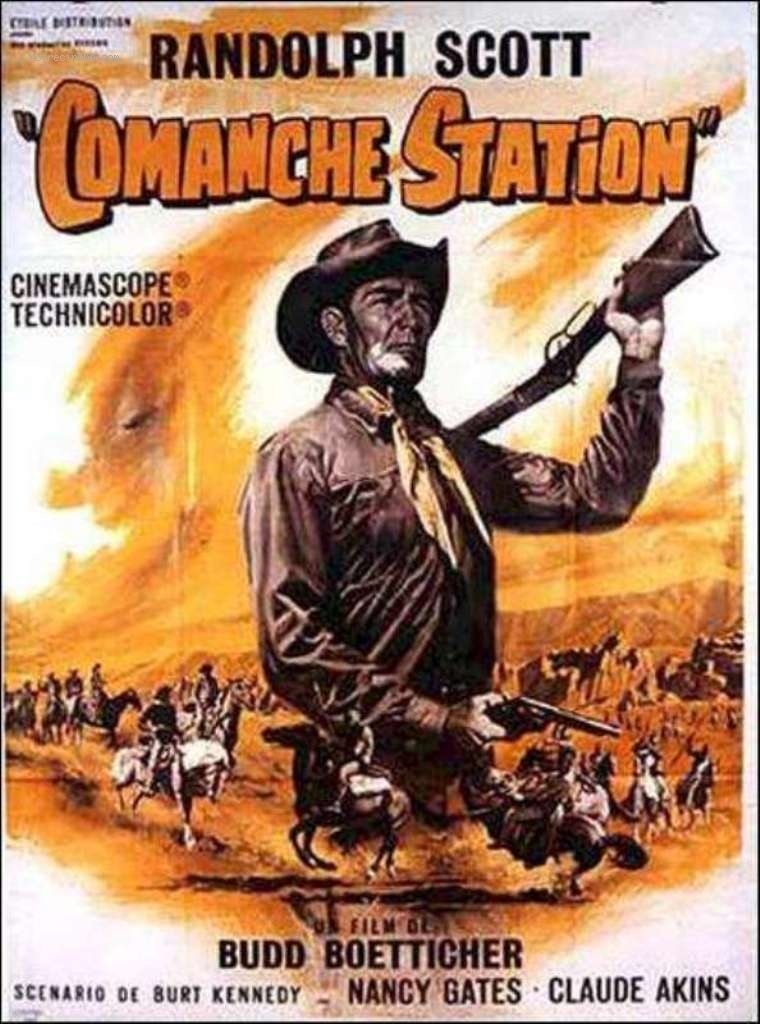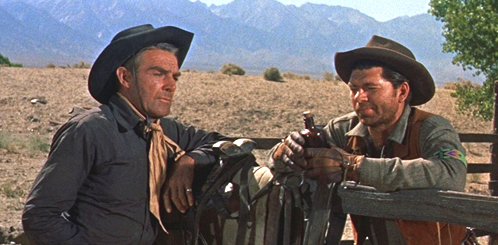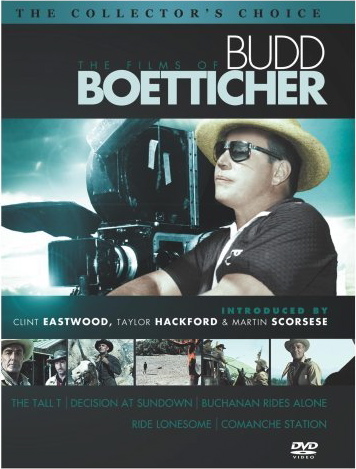My homage to Randolph Scott continues, after an hiatus. This one is near the end of the series, and the formula shows through it. Scott, as ever is a loner somewhere, sometime after the Civil War in the West. Reticent, stoic, confident, straight as the Indian arrows he dodges, here he is st age sixty-two.
 A lobby poster.
A lobby poster.
His path crosses that of a damsel in distress, and she finds the enigmatic Scott compelling, yet he a distant and perfect gentleman and she, usually, is another man’s wife. To spice up the mix there must be villains, and to the credit of these productions the chief villains are never Indians, though they are there, but other Europeans. The villains are thrown together with Scott and his charge in hostile circumstances and, in this case, they have to cooperate to avoid the Indians, but we all know a showdown is coming at about minute 70. We all know who will prevail, but the skill of the writer and director still manage surprises through the supporting players like the damsel and the naif.
Inevitably, the naif grows to admire Scott and the naif’s commitment of the Villain-in-Chief wobbles. Inevitably, the damsel misunderstands Scott’s motives and only gradually sees through that misconception to his noble core. Thus there are several nested stories. The overarching narrative is to survive the hostile circumstances and return to a town. Within that we have the menace and final confrontation with nemesis. Nested still more are the doubts of the naif and also the dawning realisation of the damsel that Scott is a knight without armour. When all these themes have played out, inevitably Scott rides off alone. Oh, and inevitably Scott wears a neckerchief. Don’t know why. To hide a scar?
Another credit to the production is that the villain has personality, and is not just the CGI cipher villain now in Hollywood productions. In this tale the villain is Claude Akins, who combines a rude charm with a bottomless evil.
 The protagonist and antagonist discuss their differences.
The protagonist and antagonist discuss their differences.
I was disappointed to see Akins’s name in the credits when it rolled off ‘Daily Motion,’ the website from which I streamed it, because I remember the caricatures he used to play on television in the 1950s and 1960s but here he projects a distinct individual who is not all bad and yet is – in a different sense – all bad. He is aided in his villainy by the ever reliable Skip Homeier, who is knocked off too early for this connoisseur of slim-balls. The villain in this formula usually has two acolytes, and third in this party is Richard Rust, otherwise unknown to me, who is a naif who has fallen into bad company and knows no way out. The list of chief villains Scott bested in these last films is impressive, starting with the most complex, Richard Boone, Lee Marvin, Pernell Roberts, Lee Van Clef, and Warren Oates, and many others.
Indians, I mentioned Indians and they are here and on the warpath, but they are also shown to be honourable. The Comanches kept the deal they made with Scott at the outset. Moreover, that they are making war is, we learn, precipitated by the murder of many of their women and children by still other bad Europeans off camera. In fact, they are victims who are lashing out at those to hand.
Scott made at least a hundred films and perhaps eighty of them were Westerns. He got type cast but he also liked that. He rode on to the screen time after time with a self-confidence and poise born from having been through it all before, again and again. It is no wonder Sheriff Bart invokes him in ‘Blazing Saddles’ (1974).
Seven of the films Scott made at the end of his career have been the object of my veneration in this homage. Why these? Because by that stage in his career, with the astute management that made him a millionaire many times over, and too old to remain under contract to a studio, he was a free agent who could decide what he wanted to do and then do it. This he did with some long time friends and associates producer Harry Brown, director Budd Boetticher, and writer Burt Kennedy. They were made in the Alabama Hills on the east side of the Sierra Madres. Each films includes many elegiac passages as the cast travel through the area. All of them also put the life-and-death human concerns against a timeless and limitless backdrop that shows just how small those concerns are in the ultimate scheme of things.
 Budd Boetticher at work.
Budd Boetticher at work.
Clint Eastwood and Martin Scorcese and others have both expressed their admiration for these films. Look for them on You Tube. It is exactly this sort of the film that George C Scott refers to in ‘They Might be Giants.’
Scott’s career culminated in one of the greatest Westerns, ‘Ride the High Country’ (1962), Sam Peckinaph’s first western, featuring a near-sighted Joel McCrea with an arthritic Scott, the ingenue Mariette Hartley, the drooling Warren Oates, and more. The gossip is that Scott and McCrea flipped a coin to see who would play which part, one a huckster and trickster and the other a pillar of unassailable integrity. Both were pitch perfect and both quit on that note. I will also sneak a peak at one of his defining films that etched itself into my prepubescent mind, ‘7th Cavalry’ (1956).
Skip to content
